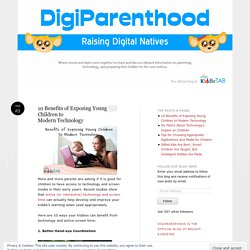

10 Benefits of Exposing Young Children to Modern Technology. More and more parents are asking if it is good for children to have access to technology and screen media in their early years.

Recent studies show that active (or interactive) technology and screen time can actually help develop and improve your kiddie’s learning when used appropriately. Here are 10 ways your kiddies can benefit from technology and active screen time: 1. Better Hand-eye Coordination Through engaging applications, children develop their hand-eye coordination further. 2. Language Skills Active screen time help children develop language skills. 3. For technology to be meaningful in early education, it must provide opportunities for children to gain the necessary skills to prepare them for school. 4. Gaming and learning applications equip children to pay more attention to details in order to complete these activities. 5. As children develop their language skills, they are able to absorb ideas that equip them with skills necessary in relating with other people. 6.
How the Use of Technology Enhances Children's Development. Through the use of technology, children learn technology skills, while enhancing social and cognitive development.

Technology Skills As children use the computer and other forms of technology, they have the opportunity to meet the following technology standards. Established by the International Society for Technology in Education (ISTE), these standards are for children ages prekindergarten through second grade (2000). Use input devices (e.g., mouse, keyboard, remote control) and output devices (e.g., monitor, printer) to successfully operate computers, VCRs, audiotapes, and other technologies. Use a variety of media and technology resources for directed and independent learning activities. Social Skills Though initially some educators expressed concern that computers might reduce socialization, researchers suggest that instead computers may increase the amount of communication and positive interaction between children (Clements, 1994; Haugland & Wright, 1997).
ED420302.pdf. Kids, Tech and Those Shrinking Attention Spans Whenever I find myself at the front of a 7th grade classroom, I keep the title of this book in mind: Teach Like Your Hair's on Fire.

This mantra serves to remind me that, short of actually lighting my hair on fire, a burning enthusiasm for the information I'm there to share is what's required to capture and hold the attention of this generation. After all, these kids have been raised in a world where access to information is instantaneous, and often entertaining, thanks to mobile technology. We hear it all the time -- increased exposure to technology is rewiring our kids' brains, making it tougher to reach and teach them. A Pew Internet survey of nearly 2,500 teachers finds that 87% believe new technologies are creating an "easily distracted generation with short attention spans" and 64% say today's digital technologies "do more to distract students than to help them academically. " Say what? This conflicting data is a reminder that the world is changing. Archived: Effects of Technology on Classrooms and Students.
A r c h i v e d I n f o r m a t i o n Change inStudent andTeacherRoles When students are using technology as a tool or a support for communicating with others, they are in an active role rather than the passive role of recipient of information transmitted by a teacher, textbook, or broadcast. The student is actively making choices about how to generate, obtain, manipulate, or display information. Technology use allows many more students to be actively thinking about information, making choices, and executing skills than is typical in teacher-led lessons. Moreover, when technology is used as a tool to support students in performing authentic tasks, the students are in the position of defining their goals, making design decisions, and evaluating their progress. The teacher's role changes as well. Project-based work (such as the City Building Project and the Student-Run Manufacturing Company) and cooperative learning approaches prompt this change in roles, whether technology is used or not.
Why Integrate Technology into the Curriculum?: The Reasons Are Many. VIDEO: An Introduction to Technology Integration Running Time: 5 min.

Technology is ubiquitous, touching almost every part of our lives, our communities, our homes. Yet most schools lag far behind when it comes to integrating technology into classroom learning. Many are just beginning to explore the true potential tech offers for teaching and learning. Properly used, technology will help students acquire the skills they need to survive in a complex, highly technological knowledge-based economy. Integrating technology into classroom instruction means more than teaching basic computer skills and software programs in a separate computer class. Many people believe that technology-enabled project learning is the ne plus ultra of classroom instruction. The myriad resources of the online world also provide each classroom with more interesting, diverse, and current learning materials.
Technology in the Classroom: The Benefits of Blended Learning.